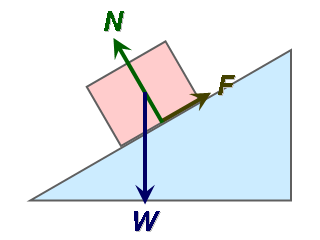Friction
What is friction? Friction is the resistance of motion when one object rubs against another. Anytime two objects rub against each other, they cause friction. Friction works against the motion and acts in the opposite direction.
Friction and Energy
When one object is sliding on another it starts to slow down due to friction. This means it loses energy. However, the energy doesn't disappear. It changes from moving energy (also call kinetic energy) to heat energy. This is why we rub our hands together when it's cold. By rubbing them together we generate friction and, therefore, heat.

The force F of friction pushes back on the block.
Preventing Friction
In some cases we want to prevent friction so it's easier to move. A good example of this is a ball or wheel. They roll to help reduce friction. Another way to reduce friction is with a lubricant like grease or oil. Machines and engines use grease and oil to reduce friction and wear so they can last longer.
Another way to reduce friction is to change the types of materials in contact with one another. For example, ice contacting with steel would produce less friction than rubber would on concrete. This is why ice skates slide so easily on the ice, but you don't slip when wearing rubber shoes on the sidewalk. These different materials are said to have different "coefficients of friction".
Using Friction
Friction is also a great help to us. After all, we would all just be sliding around everywhere if there wasn't friction to keep us steady. Friction is used in car brakes, when we walk or climb a hill, making a fire, skiing down a hill, and more.
Experiment with Friction
Different types of surfaces create different amounts of friction. Some materials are much smoother than others. Take three flat objects with different types of surfaces. Set them on one end of a tray and slowly lift it. The item with the least friction will start to slide first.
There are two main factors that will influence the total amount of friction: 1) the roughness of the surfaces (or the "coefficient of friction") and 2) the force between the two objects. In this example, the weight of the object combined with the angle of the tray will change the force between the two objects. Play around with different objects and see how these two factors change the friction.
- Dry Friction - This is what we've been mostly talking about here. Dry friction occurs when two solid objects touch each other. If they are not moving, it is called static friction. If they are moving, it is called kinetic or sliding friction.
- Fluid Friction - Fluid friction involves a fluid or air. The air resistance on an airplane or water resistance on a boat is fluid friction.
- Rolling Friction - Rolling friction occurs when a round surface rolls over a surface, like a ball or wheel.
- Although wheels are great for rolling and reducing friction, they couldn't work without friction.
- It would be really tough just to stand up without friction.
- Friction can generate static electricity.
- The harder two surfaces are pressed together, the more force it takes to overcome the friction and get them to slide.
- Fluid friction is used a lot in water parks so we can slide smoothly and fast down giant slides.